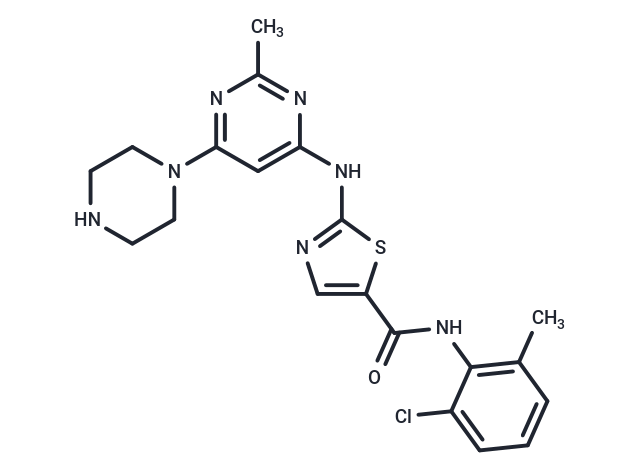Shopping Cart
- Remove All
 Your shopping cart is currently empty
Your shopping cart is currently empty

N-Deshydroxyethyl Dasatinib (N-Deshydroxyethyl BMS-354825) is a metabolite of Dasatinib, a dasatinib-based molecule that degrades ABL by binding to the IAP ligand via a linker to form SNIPER. N-Deshydroxyethyl Dasatinib is used in the study of cancer and immune diseases.

| Pack Size | Price | Availability | Quantity |
|---|---|---|---|
| 1 mg | $84 | In Stock | |
| 5 mg | $198 | In Stock | |
| 10 mg | $313 | In Stock | |
| 25 mg | $543 | In Stock | |
| 50 mg | $789 | In Stock | |
| 100 mg | $1,080 | In Stock | |
| 500 mg | $2,180 | In Stock | |
| 1 mL x 10 mM (in DMSO) | $226 | In Stock |
| Description | N-Deshydroxyethyl Dasatinib (N-Deshydroxyethyl BMS-354825) is a metabolite of Dasatinib, a dasatinib-based molecule that degrades ABL by binding to the IAP ligand via a linker to form SNIPER. N-Deshydroxyethyl Dasatinib is used in the study of cancer and immune diseases. |
| Alias | N-Deshydroxyethyl BMS-354825 |
| Molecular Weight | 443.95 |
| Formula | C20H22ClN7OS |
| Cas No. | 910297-51-7 |
| Smiles | N(C1=CC(=NC(C)=N1)N2CCNCC2)C=3SC(C(NC4=C(C)C=CC=C4Cl)=O)=CN3 |
| Relative Density. | 1.403 g/cm3 (Predicted) |
| Storage | Powder: -20°C for 3 years | In solvent: -80°C for 1 year | Shipping with blue ice. | |||||||||||||||||||||||||||||||||||
| Solubility Information | DMSO: 49.5 mg/mL (111.5 mM), Sonication is recommended. | |||||||||||||||||||||||||||||||||||
Solution Preparation Table | ||||||||||||||||||||||||||||||||||||
DMSO
| ||||||||||||||||||||||||||||||||||||

Copyright © 2015-2025 TargetMol Chemicals Inc. All Rights Reserved.